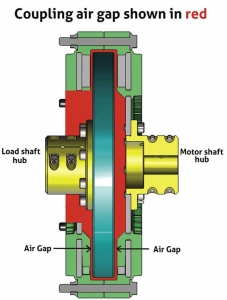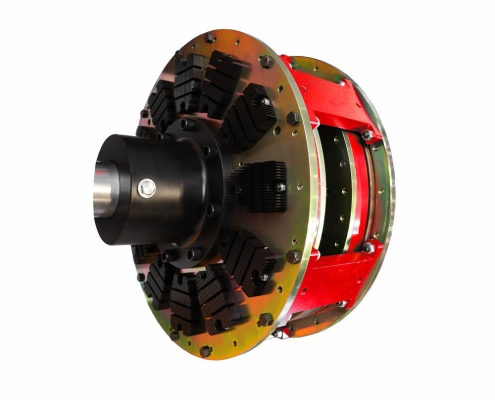 This article uses a real case to describe the advantages and disadvantages of magnetic couplers. This is a cement joint-stock company. Due to their production needs, 81 Kiln Feeding System are running online, including 44 3200t/d, 37 3200t/d, 162 storage elevators, and 81 clinker box conveyor. The roller press circulation hoist is a double drive, the cement silo hoist, the mine long belt, and the limestone reclaimer scraper all use traditional fluid couplings. There are about 30 traditional fluid couplings for each production line. And all of them can change to magnetic coupling.
This article uses a real case to describe the advantages and disadvantages of magnetic couplers. This is a cement joint-stock company. Due to their production needs, 81 Kiln Feeding System are running online, including 44 3200t/d, 37 3200t/d, 162 storage elevators, and 81 clinker box conveyor. The roller press circulation hoist is a double drive, the cement silo hoist, the mine long belt, and the limestone reclaimer scraper all use traditional fluid couplings. There are about 30 traditional fluid couplings for each production line. And all of them can change to magnetic coupling.
1 Project background
The traditional hydraulic coupling has problems: complex structure, low transmission efficiency, long replacement time for spare parts, periodic life, oil leakage and fuel injection lead to many failures and shutdowns, pollution of the environment, poor reliability, and the risk of explosion. Now the magnet coupling technology is mature and widely used, and it is easy to install, maintenance-free, energy efficient, environmentally friendly and highly reliable. After the trial of the subsidiary company, the effect is good. The magnetic coupling can replace the traditional fluid coupling, and it is recommended to popularize and apply it.
2 Problems existing in traditional fluid couplings
(1) Low transmission efficiency; (2) Life is periodic; (3) When overloaded, the fusible plug of the liquid coupler melts and injects fuel, which pollutes the environment; (4) The internal structure is complex and maintenance is difficult; (5) There is a risk of explosion.
3 Comparison of the traditional fluid coupling and magnetic coupling
3.1 Working principle and existing problems of hydraulic coupling
(1) Working principle
A hydrodynamic coupling is a sealing mechanism containing two annular discs. The driving wheel is called the pump wheel, the driven wheel is called the turbine, and both the pump wheel and the turbine are called the working wheel. In the annular casing of the impeller, many vanes are arranged radially. After the pump impeller and the turbine are assembled, an annular cavity is formed, which is filled with working oil. The pump wheel is usually driven by an internal combustion engine or motor to rotate, driving the working oil to make a ratio. More complex centripetal motion. The high-speed flowing oil impacts the turbine blades under the action of Coriolis force, and transmits kinetic energy to the turbine, so that the turbine and the pump wheel rotate in the same direction. The oil flows from the blade edge of the turbine back to the pump impeller, forming a circulation loop, the flow path of which is like an end-to-end annular spiral.
(2) Problems in the use
Easy to inject fuel, low transmission efficiency, periodic life, long time to deal with failure, risk of explosion and injury, etc.
3.2 Working principle and characteristics of magnetic coupling
(1) Working principle
A device that works on the principle of magnetic induction. It consists of two independent parts without rigid connection, namely a conductor disk assembly equipped with a copper ring and a magnet disk assembly equipped with a strong rare earth permanent magnet, which are respectively connected to the motor shaft through the split hub connected with the load shaft, see Figure 1. At rest, the conductor disk is in the magnetic field generated by the permanent disk (permanent magnet). When the conductor disk rotates with the motor shaft, the conductor disk will cut the magnetic field lines, thereby generating eddy currents on the conductor disk, which in turn will generate an induced magnetic field. A force is generated between the induced magnetic field and the magnetic field of the magnet disk to prevent the relative movement of the two, thereby realizing the torque transmission function between the motor and the load. 
The core value is to make the transmission safer, simpler, more energy-saving and more environmentally friendly.
(2) Features
1) Flexible start, reduce the inrush current of the motor and prolong the service life of the equipment; 2) Vibration isolation, no mechanical connection, prolong the service life of the main components of the transmission system (bearings, seals, etc.); 3) Simple structure, maintenance-free, no wearing parts, high reliability, and can adapt to harsh environments; 4) Small size, easy installation, no need to move the foundation for the transformation of the system, and low investment and transformation costs; 5) Efficient torque transmission, allowing impact loads; 6) The service life is long, up to 30 years, and the comprehensive cost performance of the whole life cycle is the highest; 7) No hydraulic oil, no environmental pollution; 8) Magnetic levitation drive, vibration isolation, and noise reduction, no temperature rise problem; 9) No extra friction and no lubrication to keep the equipment running at high efficiency. Magnetic couplings are widely used in building materials, water industry/sewage treatment, petroleum, natural gas, metallurgy, iron and steel chemical industry, fans, etc., and the operation is relatively stable. A comprehensive comparison of magnetic coupling and fluid coupling is shown in Table 1.
| Table 1 Comprehensive comparison of magnetic coupling and fluid coupling | ||
| Performance characteristics | Torque-limited fluid coupling | Torque-limited magnetic coupling |
| Hydraulic Oil | Needs Hydraulic Oil | No Hydraulic Oil |
| polluted environment | Yes | No |
| Safety | Poor and there is a risk of explosion. | Very Safe |
| The soft-start effect | Better | Compared with the hydraulic coupling, the starting current is reduced by about 50%. |
| Vibration isolation | Can not isolate vibration in all directions, | Non-contact, all-round isolation vibration. |
| Overload protection function | The fusible plug melts and injects fuel, and the recovery time is long. | Short recovery time, fast automatic reset. |
| The locked rotor protection | Fusible plug melts and the hydraulic oil is sprayed out. | The specially designed guide key structure ensures the automatic release protection of the locked rotor. |
| Alignment | Very high centering requirements | Axial, radial 0.76mm |
| Working temperature | Ambient temperature requires -20℃ to use silicone rubber seal; above +40℃ to use fluorine rubber seal. | -40℃~+80℃ can be used |
| Maintenance | requires regular calibration and replacement of hydraulic oil. | Maintenance free (no electricity, no oil, no wear). |
| Installation and removal of | hot-loading, installation and removal requires more than 1d. | The split hub is cold-installed to ensure the locking torque, 2h for installation and 0.5h for disassembly. |
| Service life/year | 8 year | 20-30years |
4 Estimation of the impact of hydraulic coupling on production
Downtime and impact due to hydraulic couplings and related accessories in 2019 The yields are shown in Table 2.
| Table 2 Fluid couplings and related accessories cause downtime and impact production(2019) | |||
| Serial Number | System | Downtime/h | Affect Output/Tons |
| 1 | Kiln Feeding System | 90.93 | 2.4 |
| 2 | Clinker system | 80 | 1.59 |
| 3 | Cement | 165 | 2.76 |
| 4 | finishing process | 23.2 | 0.36 |
| 5 | blast-furnace cement | 6.37 | 0.05 |
5 Magnetic coupling application case and energy-saving improvement plan
(1) The company’s current transformation and application: the transformed equipment includes Kiln Feeding System, storage elevators, clinker box conveyor, roller press circulating hoist, limestone reclaimer, etc., mainly concentrated in limited space at height, difficult to troubleshoot, The host equipment with long kiln downtime. 130 sets of renovations have been completed, and the effect is good. (2) Improvement plan: It is planned to complete the transformation of 150 conveying equipment every year from 2020 to 2022. Priority should be given to the transformation of limestone reclaimer scrapers, mine long belts, roller press circulation hoists, storage elevators, kiln feeding elevators, inclined clinker box conveyor and other host equipment. (3) Disposal plan for alternative fluid coupling: reserved on site for use as a backup machine or transferred to other systems.
6.Status of magnetic coupling technology in China
At present, China has mastered the basic techniques of magnetic coupling, independent research and development, design and manufacture, and there are few domestic production enterprises. Judging from the current investigation and communication, magnetic couplings have entered the cement industry for a period of time. In the early stage, due to the high price (about 10 times that of ordinary fluid coupling), they were used less frequently. 5 times), more and more traditional fluid couplings are being replaced by host equipment, with good use effect, significantly reduced downtime, high equipment reliability and maintenance-free, and are used more and more in the cement industry.
7 Conclusion
Compared with the traditional fluid coupling, the magnetic coupling has the following advantages: simple structure, maintenance-free, no wearing and consumable parts, high reliability, adapt to harsh environments. small size, easy installation, no need for a moving foundation to transform the system. High-efficiency torque transmission, allowing shock loads; long service life (up to 30 years) the highest comprehensive cost performance throughout the life cycle. no risk of explosion, no additional friction, no need for lubrication to keep the equipment running at high efficiency. As a mature product, magnetic coupling can be popularized and used in the cement industry.
